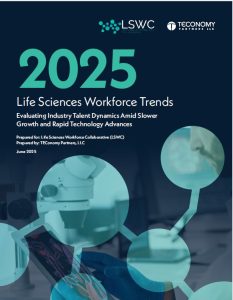Boston, MA, June 24, 2025 – The Life Sciences Workforce Collaborative (LSWC), formerly the Coalition of State Bioscience Institutes (CSBI), today released its 2025 National Life Sciences Workforce Trends Report, the seventh edition of this landmark study, at the 2025 BIO International Convention in Boston.
Developed in partnership with TEConomy Partners, LLC, with support from InnovATEBIO, the National Biotechnology Education Center, the biennial report captures an evolving talent landscape across the U.S. life sciences sector. Drawing on survey responses from over 500 companies, 200 executive interviews, and 2.9 million job postings, the 2025 edition reflects a more complex, cautious industry posture as companies respond to macroeconomic pressures, talent availability, and rapid digital transformation.¹

2025 Life Sciences Workforce Trends Report The 2025 National Life Sciences Workforce Trends Report, developed by LSWC in partnership with TEConomy Partners, offers a data-driven snapshot of workforce challenges and opportunities in a time of tempered industry growth and rapid technological change. Drawing from over 500 company survey responses, 200 executive interviews, and 2.9 million job postings, the report reveals four key themes: strategic hiring amid slower growth, widespread integration of AI and automation, increased investment in upskilling incumbent workers, and a surge in early STEM engagement. These insights serve as a critical guide for industry, education, and policy leaders shaping the future of the bioeconomy.
“This report illustrates a new era in workforce dynamics—where slower overall growth is paired with opportunity in key areas, growing emphasis on upskilling, and a shift toward technology-integrated roles,” said Liisa Bozinovic, Executive Director of Oregon Bio and Chair of LSWC. “Even as companies weather economic uncertainty, their long-term commitment to workforce development remains clear.”
Key findings from the 2025 report include:
- Moderated hiring, but continued growth in select subsectors. After a period of intense hiring post-pandemic, industry employment saw a slight contraction in 2024. Yet major companies have announced more than $200 billion in new domestic manufacturing and R&D investments, suggesting robust long-term potential.²
- AI and automation are reshaping talent demand. AI adoption is widespread—particularly among larger firms—and is driving demand for “bilingual” talent who can bridge life sciences and digital fluency.³
- Upskilling incumbent workers is a top priority. Companies are investing more in continuous training, internal mobility, and performance-based credentialing to meet evolving skill needs, especially in manufacturing and regulatory roles.⁴
- STEM education engagement is on the rise. Compared to 2023, twice as many companies report classroom engagement and mentorship at the K-12 level, reinforcing a long-term investment in the life sciences talent pipeline.⁵
“As emphasized by the National Security Commission on Emerging Biotechnology, keeping pace with the rapidly evolving skills and talent needs of the biotechnology sector is essential to U.S. leadership in this industry,” said Linnea Fletcher, Executive Director of InnovATEBIO, the NSF-supported National Biotechnology Education Center. “Our national network of advanced technical education programs is working rapidly to build the next generation of biotech talent—one that is nimble, industry-aligned, and ready to power the biotechnology revolution.”
This 2025 report is the first released under the new LSWC identity, which reflects the organization’s broadened mission to unite state and regional bioscience associations in a coordinated national strategy for life sciences workforce development. The LSWC was originally founded as CSBI in 2012.
“America’s leadership in the life sciences depends on the talent of our people,” said John Crowley, President & CEO of the Biotechnology Innovation Organization (BIO). “This report from the LSWC provides vital insight into the challenges—and the opportunities—ahead for building a workforce that can harness the full potential of innovation. At BIO, we are proud to support these efforts and to champion policies that strengthen our industry’s talent pipeline, from the classroom to the lab and beyond.”
The full 2025 Life Sciences Workforce Trends Report is available at www.lifesciencesworkforce.org or by clicking here.
- Download the Key Report Findings
The LSWC thanks its Investor-level supporters: AZBio/AZ Advances, Biocom California/Institute, BioNJ, BioUtah, California Life Sciences, Colorado Bioscience Association/Institute, Georgia Life Sciences/Institute, MichBio, NewYorkBIO, Ohio Life Sciences, Oregon Bio, SCbio, and SoCalBio. For a complete list of our growing partners and supporters visit the www.LifeSciencesWorkforce.org.
About the Life Sciences Workforce Collaborative (LSWC)
The Life Sciences Workforce Collaborative (LSWC) is a national nonprofit coalition of state, regional and national life science associations and institutes who are working together to build a competitive, and future-ready life sciences workforce. Originally founded in 2012 as the Coalition of State Bioscience Institutes (CSBI), LSWC connects industry, academia, and government partners through data-driven insights, best practice sharing, and collaborative programs. Learn more at www.LifeSciencesWorkforce.org.
About TEConomy Partners, LLC
TEConomy Partners, LLC is a global leader in research, analysis and strategy for innovation-driven economic development. Today we’re helping nations, states, regions, universities and industries blueprint their future and translate knowledge into prosperity. The principals of TEConomy Partners include the authors of the biennial TEConomy/BIO State Bioscience Development reports, published since 2004. For further information, please visit www.teconomypartners.com.
¹ Life Sciences Workforce Collaborative and TEConomy Partners, 2025 Life Sciences Workforce Trends Report: Evaluating Industry Talent Dynamics Amid Slower Growth and Rapid Technology Advances, June 2025, pp. 1–4. (Data sources: 523 survey responses, 205 executive interviews, 2.9 million unique job postings.)
² Ibid., pp. 5–13. (Details on moderated industry hiring, sector-specific contraction in 2024, and more than $200B in announced domestic life sciences investments.)
³ Ibid., pp. 15–22. (Focus on AI, machine learning, and automation as drivers of workforce transformation; demand for cross-functional and digitally fluent talent.)
⁴ Ibid., pp. 23–28. (Trends in incumbent worker training, microcredentials, and upskilling strategies in manufacturing and compliance roles.)
⁵ Ibid., pp. 29–31. (Surge in employer engagement with K–12 STEM initiatives; significant increases in mentorship and classroom involvement compared to 2023.)
